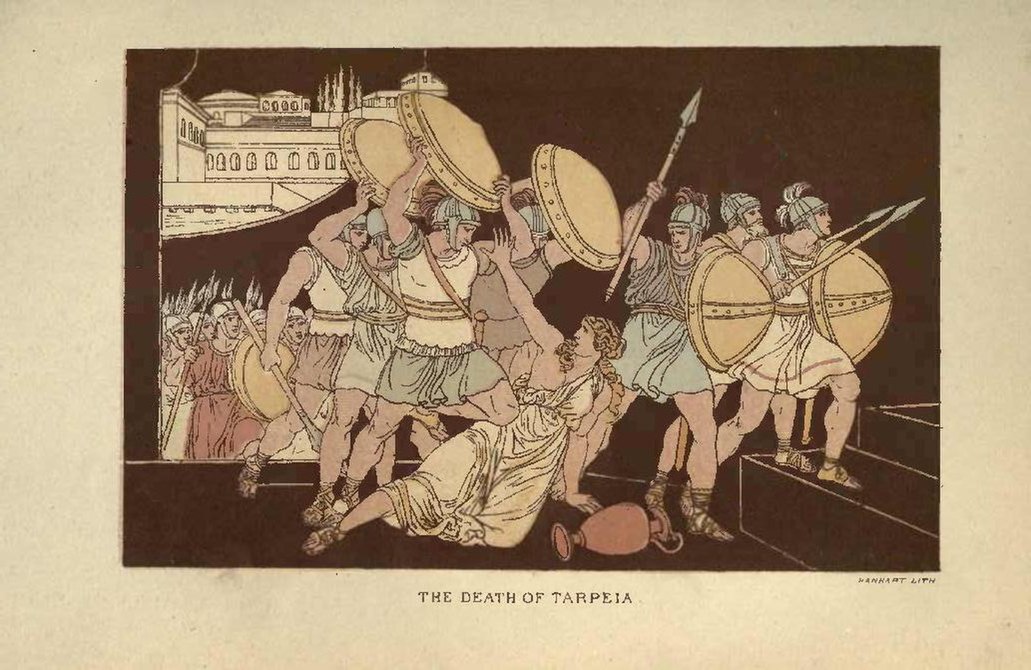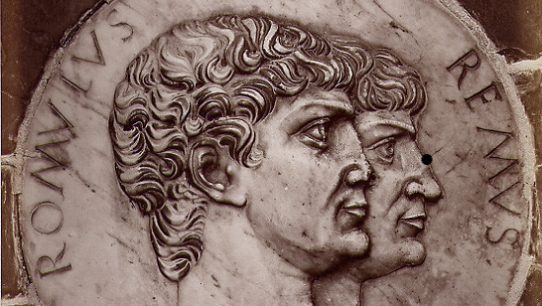Tarpeia is a brief but piercing episode in Rome’s earliest cycle. It is the story of betrayal at the cradle of the city and of a punishment that becomes geography and law.
A single act exposes the fragile boundary between civic loyalty and private gain. In the harsh clarity of early Rome, the sentence is not only death — it is memory carved into stone so that future generations will know what a city allows and what it forbids.
Characters and Setting
The scene belongs to the time of Romulus and the young city on its hills. The Sabines, under King Titus Tatius, press Rome hard. The citadel on the Capitoline must hold.
Tarpeia, daughter of the Roman commander Spurius Tarpeius, has access to the gate. The Sabines’ shields glitter with gold. Whether she is greedy for ornaments or deceived by a promise is debated by the ancient sources.
What matters is her bargain: she agrees to open the way in exchange for what the warriors wear on their left arms.
Night Bargain
Under cover of darkness, Tarpeia admits the Sabines. She expects bracelets, perhaps the round fibulae that fasten cloaks. Instead, she receives the literal fulfillment of her request. The Sabines crush her with their shields, which are also borne on the left arm. The weight of bronze and scorn buries her on the slope of the Capitoline.
The path becomes known as the Tarpeian Rock — a name that, in Rome, will be synonymous with traitors cast to their deaths.
War and Reprieve
The Sabine incursion leads to pitched battle in the Forum — the same conflict that will be halted by the courage of the Sabine Women. Tarpeia’s death is not undone by the later truce. Her story remains as a negative founding tale. Romulus’s Rome will admit new peoples and reconcile old enemies, but it will not sanctify betrayal for private wealth.
The city binds itself with a code written in walls, rituals, and place names. Among these, the Tarpeian Rock declares that loyalty is a matter of life and death.
Motives and Moral Debate
Ancient writers argue over Tarpeia’s heart. Was she simply greedy? Was she attempting a stratagem to disarm the enemy? Was she compelled?
The ambiguity works like a mirror. Rome chooses to remember an outcome rather than excuse an intention. The lesson is juridical as well as moral. In a city founded on law and sacred boundaries, the act of opening a gate to an enemy is beyond pardon. The weight of the shields expresses the weight of a broken oath.
Symbolism and Interpretation
Tarpeia is Rome’s early meditation on the limits of inclusion. The same narrative cycle that celebrates reconciliation also erects a warning. The bracelets and shields stand for the double temptation of beauty and power. The bargain shows how language can be turned against justice when words are severed from common meaning. The rock becomes a public pedagogy.
Geography is made to teach habit. Citizens who pass the cliff feel the law in the body before they hear it in the forum.
Afterlife of a Name
For centuries, the phrase “from the Capitol to the Tarpeian Rock” meant the swift fall from high honor to disgrace.
Historians used Tarpeia to illustrate how liberty requires vigilance. Poets used her to explore the ethics of intention and result. Artists depicted the crushing weight of shields as a stark tableau of judgment without ornament.
The story is severe, perhaps too severe for modern sympathy. Yet it preserves a hard wisdom: a community cannot live by charm; it must keep faith with itself.
Cultural Legacy
The myth enters Roman civic memory as both threat and promise. The threat is against treachery. The promise is that justice will be visible and communal, not secret or capricious.
The city that will later rule nations begins by governing its own heart. The rock below the Capitol becomes part of that governance. It is the city’s rough altar to loyalty — an uncarved statute more persuasive than written law.
Gods involved: Neptune, Mars, Jupiter.
Based on classical sources in the public domain, including Livy’s Ab Urbe Condita and translations available via Project Gutenberg and Wikisource.








